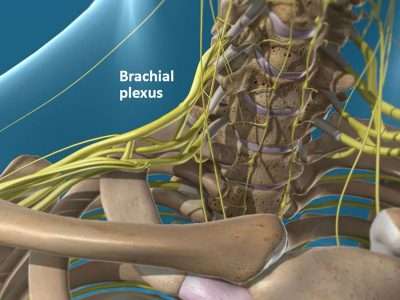 An interscalene block (also called “interscalene brachial plexus block” and “interscalene nerve block”) refers to the placement of local anesthetic around the brachial plexus near scalene muscles. The procedure provides pain management for shoulder and upper arm surgery patients. After surgery, an interscalene block can help the patient begin physical therapy and other treatments to speed the healing process.
An interscalene block (also called “interscalene brachial plexus block” and “interscalene nerve block”) refers to the placement of local anesthetic around the brachial plexus near scalene muscles. The procedure provides pain management for shoulder and upper arm surgery patients. After surgery, an interscalene block can help the patient begin physical therapy and other treatments to speed the healing process.
The first brachial plexus blocks were performed in 1885 in New York City. Many surgeons perform shoulder surgery using an interscalene block in conjunction with general anesthesia.
In This Article:
- What Are the Scalene and Brachial Plexus?
- What is an Interscalene Block?
- How Does an Interscalene Block Work After Surgery?
- Conditions Treated with an Interscalene Block
- Who Can Benefit from an Interscalene Block?
- Novus Spine & Pain Center
- Interscalene Block Resources
What Are the Scalene and Brachial Plexus?
The scalene is a group of muscles located on each side of the neck that allows the neck to bend and rotate. They also assist in breathing by raising the first and second ribs.
The brachial plexus is a system of nerves located in the neck and upper trunk that passes between the anterior and middle scalene muscles. These nerves are responsible for sensation and motion in the shoulders, upper arms, forearms, and hands.
What Is an Interscalene Block?
An interscalene block is a form of localized pain management in which the brachial plexus nerves are anesthetized to help stop pain signals from reaching the brain. The procedure is often used during shoulder surgery to reduce the amount of general anesthesia. Using less general anesthesia during surgery can help reduce post-operative nausea.
The block is also often used to provide pain relief following shoulder surgery. Managing the pain helps the patient with physical therapy and other treatments to begin the healing process, rebuild strength, and regain range of motion.
How Does an Interscalene Block Work After Surgery?
Shoulder surgery often comes with a significant amount of pain. But the surgery is just the beginning of the healing process. Inactivity after any surgery can slow the recovery process, and limiting shoulder movement after surgery can possibly result in a frozen shoulder. An interscalene block can be helpful with the rehabilitation process, providing pain management while the patient is in physical therapy to restore range of motion and strength.
The anesthetic agent used in an interscalene block helps reduce pain signals normally between 8- to 24-hours. It typically begins wearing off between 12- to 16-hours after the injection. Though an interscalene block generally lasts less than a day, it is usually enough to either supplement pain medications during surgery or allow for extra pain relief after surgery.
One way to make an interscalene block last longer is by temporarily implanting a small flexible catheter near the brachial plexus nerves to allow for multiple injections of the numbing medicine in the shoulder following surgery. The anesthesiologist places the catheter during the surgery.
Conditions Treated with an Interscalene Block
An interscalene block can be helpful in treating arthroscopic or open shoulder surgery as well as these injuries and conditions.
- Acromioplasty (removing bone from the shoulder blade).
- Arm surgery that does not involve the forearm or hand.
- Clavicle (collarbone) fracture.
- Hemiarthroplasty (shoulder blade head replacement).
- Humerus (upper arm) fracture.
- Labral (shoulder joint cartilage) repair.
- Rotator cuff
- Total shoulder replacement.
Who Can Benefit from an Interscalene Block?
The pain following shoulder surgery sometimes leads to the patient limiting their movement, which can contribute to a delay in a full recovery. Typically, shoulder surgery patients are provided with a self-controlled pain pump (patient-controlled analgesia, or PCA) to help control pain.
A study compared pain control with a PCA alone and a PCA combined with an interscalene nerve block in patients following shoulder surgery and found that patients on PCA with an interscalene nerve block required less pain medication and had less nausea following their surgery.
Novus Spine & Pain Center
Novus Spine & Pain Center is in Lakeland, Florida, and treats patients with chronic pain with numerous therapies, including Interscalene Block. By using a comprehensive approach and cutting-edge therapies, we work together with patients to restore function and regain an active lifestyle, while minimizing the need for opiates.
For your convenience, you may schedule an appointment online, request a call back, or call our office at 863-583-4445.
Interscalene Block Resources
Interscalene Nerve Block (Medscape)
Patient Guide to Anesthesia and Pain Control for Shoulder Surgery (Johns Hopkins)
Interscalene Brachial Plexus Block – Landmarks and Nerve Stimulator Technique (New York School of Regional Anesthesia (NYSORA))
Effects of Interscalene Nerve Block for Postoperative Pain Management in Patients after Shoulder Surgery (PubMed)
Important Information about Interscalene Block (Touro)
Brachial Plexus Injury (Johns Hopkins)
Scalene (Physiopedia)
Scalene Muscle (Free Dictionary)
Interscalene Block Image Gallery (Novus Spine & Pain Center)

